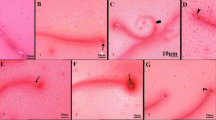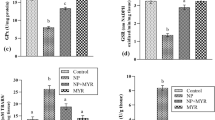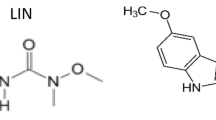Abstract
The aim of this study was to explore the adverse effects of lindane pesticide on testes and epididymus weight, sperm head counts, sperm motility, abnormal changes in sperm morphology, biochemical changes in endogenous antioxidants and oxidative enzymes in male wistar rats as well as to assess ameliorating role of ‘curcumin’. Rats were exposed daily to lindane (30 mg/kgbw) for 14 and 28 days and administered with curcumin (100 mg/kgbw) in pretreatment, post treatment and combination groups. We observed decrease (p < 0.001) in testes and cauda epididymus weight, decrease (p < 0.001) in testicular sperm head count, increase (p < 0.001) in abnormal tail morphology (headless tail, multiple tail, broken tail, coiled tail and bent tail), abnormal head morphology (excessive hook, amorphous head, pin head, short head, blunt hook and detached hook) and decrease (p < 0.001) in sperm motility after lindane exposure, as compared to control. There was (p < 0.01) decline in superoxide dismutase, catalase and glutathione-s-transferase activity on lindane exposure, however, no change (p > 0.05) was observed in glutathione level. Lipid peroxidation was (p < 0.01) enhanced on lindane exposure as compared to control. Curcumin administration was able to ameliorate lindane induced reproductive toxicity in pretreatment, post treatment and combination groups. The study indicated that even after 14 days of metabolism, toxic effects of lindane were evident.


Similar content being viewed by others
References
Ahmad RS, Suke SG, Seth V, Chakraborti A, Tripathi AK, Banerjee BD (2006) Protective effects of dietary ginger (Zingiber officinalis Rosc.) on lindane induced oxidative stress in rats. Int J Food Sci Nutr 57:65–73
Ak T, Gülcin I (2008) Antioxidant and radical scavenging properties of curcumin. Chem Biol Interact 174:27–37
Anilakumar KR, Khanum F, Santhanam K (2006) Amelioration of hexachlorocyclohexane induced oxidative stress by Amaranthus leaves in rats. Plant Food Hum Nutr 61:169–173
Antunes-Madeira MC, Almeida LM, Madeira VMC (1993) Depth-dependent effect of DDT and lindane on the fluidity of native membranes and extracted lipids. Implications for mechanism of toxicity. Bull Environ Contam Toxicol 51:787–794
Arisi AC, Simizu K, Kogake M, Bainy AC, Silva MA, Barros SB, Boveris A, Videla LA, Junqueira VB (1994) Brain and liver lipid peroxidation level following acute and short term lindane administration in the rats. Toxicol Lett 74:61–68
Chitra KC, Latchoumycandane C, Mathur PP (1999) Chronic effect of endosulphan on testicular function of rats. Asian J Androl 4:203–206
Chitra KC, Sujata R, Latchoumycandane C, Mathur PP (2001) Effect of lindane on antioxidant enzymes in epididymus and epididymal sperm rats. Asian J Androl 3:205–208
Choi EK, Tsunekawa N, Kanai Y, Kurohmaru M (2008) A new protocol for measurement of testicular sperm production. J Reprod Dev 54:90–93
Claiborne A (1985) Catalase activity. In: Greenwald R (ed) Handbook of methods for oxygen radical research. CRC Press, Baco Raton, pp 283–284
Dalsenter PR, Faqi AS, Webb J, Merker HJ, Chahoud I (1996) Reproductive toxicity and tissue concentration of lindane in adult male rats. Hum Exp Toxicol 15:406–410
Habig WH, Pabst UJ, Jakoby WB (1974) Glutathion-S-transferases. The first enzymatic step in mercapturic acid formation. J Biol Chem 249:7130–7139
Halliwell B, Gutteridge JMC (1984) Oxygen toxicity, oxygen radicals, transition metals and disease. Biochem J 219:1–14
Hugenholtz AP, Bruce WR (1979) Sperm size abnormalities in homozygous and heterozygous in (5) 9 RK mice. Can J Genet Cytol 21:115–119
Ichikawa T, Oeda T, Ohmor H, Schill WB (1999) Reactive oxygen species influence the acrosome reaction but not activity in human spermatozoa. Int J Androl 22:37–42
Jollow D, Mitchell L, Zampaglione N, Gillete J (1974) Bromobenzene induced liver necrosis: protective role of glutathione and evidence for 3,4-bromobenzenoxide as the hepatotoxic intermediate. J Pharmacol 11:151–169
Junqueira VB, Bainy AC, Arisi AC, Azzalis LA, Simizu K, Pimentel R, Barros SB, Videla LA (1994) Acute lindane intoxication: a study on lindane tissue concentration and oxidative stress related parameters in liver and erythrocytes. J Biochem Toxicol 9:9–15
Kono Y, Fridovich I (1982) Superoxide radical inhibits catalase. J Biol Chem 257:5751–5754
Krzanowska H (1976) Types of sperm head abnormalities in four inbred strain of mice. Acta Biol Cracov (Ser Zool) 19:79–85
Lowry OH, Rosenbrough NJ, Farr AL, Randall RJ (1951) Protein measurement with folin-phenol reagent. J Biol Chem 193:265–275
Lubbad AS, Oriowo MA, Khan I (2009) Curcumin reverses attenuated carbachol-induced contraction of the colon in a rat model of colitis. Scand J Gastroenterol 44:187–194
Luthra PM, Singh R, Chandra R (2001) Therapeutic uses of curcuma longa. Indian J Clin Biochem 16:153–160
Mathur PP, Chatopadhyay S (1982) Involvement of lysosomal enzymes in flutamide-induced stimulation of rat testes. Andrologia 14:171–176
Misra HP (1989) Adrenochrome assay. In: Greenwald AR (ed) Handbook of methods for oxygen radical research. CRC Press, Boca Raton, pp 237–242
Perkins S, Verschoyle RD, Hill K, Parveen I, Threadgill MD, Sharma RA, Williams ML, Steward WP, Gescher AJ (2002) Chemopreventive efficacy and pharmacokinetics of curcumin in the min/+mouse, a model of familial adenomatous polyposis. Cancer Epidemiol Biomarkers Prev 11:535–540
Portig J, Kraus P, Stein K, Koransky W, Noack G, Gross B, Sodomann S (1979) Glutathion conjugate formation from hexachlorocyclohexane (HCH) in the rat. Xenobiotica 9:353–378
Priyadarshini KI (1999) Free radical reactions of curcumin in membrane models. Free Rad Biol Int 23:838–848
Reddy ACP, Lokesh BR (1994) Studies on the inhibitory effect of curcumin and euganol on the formation of reactive species and the oxidation of ferrous iron. Mol Cell Biochem 137:1–8
Sahoo DK, Roy A, Chainy GBN (2008) Protective effect of vitamin E and curcumin on L-thyroxine-induced rat testicular oxidative stress. Chem-Biol Interact 176:121–128
Samanta L, Chainy GBN (1997) Comparison of hexachlorocyclohexane induced oxidative stress in the testis of immature and adult rats. Comp Biochem Physiol 118C:319–327
Samanta L, Chainy GBN (2002) Response of testicular antioxidant enzymes to hexachlorocyclohexane is species specific. Asian J Androl 4:191–194
Samanta L, Sahoo A, Chainy GBN (1999) Age related changes in rat testicular oxidative stress parameters by hexachlorocyclohexane. Arch Toxicol 73:96–107
Solomon LW, Fahmer L, West DP (1977) Gamma benzene hexachloride toxicity. Arch Dermatol 113:353–357
Sreejayan N, Rao MN (1996) Free radical scavenging activity of curcuminoids. Arzneimittelforschung 46:169–171
Strimpakos AS, Sharma RA (2008) Curcumin: preventive and therapeutic properties in laboratory studies. Antioxid Redox Signal 10:511–545
Sujatha R, Chitra KC, Latchoumycandane C, Mathur PP (2001) Effect of lindane on testicular antioxidant system and steroidogenic enzymes in adult rats. Asian J Androl 3:135–138
Turk G, Attesahin A, Sonmez M, Yuce A, Ceribasi AO (2007) Lycopene protects against cyclosporine A induced testicular toxicity in rats. Thereogenology 67:778–785
Verma SP, Rastogi A, Lin PS (1992) Hexachlorocyclohexane pesticide reduces survival and alter plasma membrane structure of Chinese Hamster V79 cells. Arch Biochem Biophys 298:587–593
WHO Report (1991) International programme on chemical safety. In: Health and safety Guide-54 Lindane. WHO, Geneva, p 14. http://www.inchem.org
Williams J (1993) Semen analysis and fertility assessment in rabit. In: Chapin RE (author), Heindel JJ (ed) Methods in toxicology, vol 3 part A. Academic Press, pp 344–350
Wolff GL, Roberts DW, Morrisey RL, Greenman DL, Allen RR, Cambell WL, Bergman H, Nesnow S, Frithch CH (1987) Tumorigenic responses to lindane in mice: potentiation by a dominant mutation. Carcinogenesis 8:1889–1897
Wright JR, Colby HD, Miles PR (1981) Cytosolic factor which effect microsomal lipid peroxidation in lung and liver. Arch Biochem Biophys 206:296–304
Author information
Authors and Affiliations
Corresponding author
Rights and permissions
About this article
Cite this article
Sharma, P., Singh, R. Protective Role of Curcumin on Lindane Induced Reproductive Toxicity in Male Wistar Rats. Bull Environ Contam Toxicol 84, 378–384 (2010). https://doi.org/10.1007/s00128-010-9942-y
Received:
Accepted:
Published:
Issue Date:
DOI: https://doi.org/10.1007/s00128-010-9942-y




